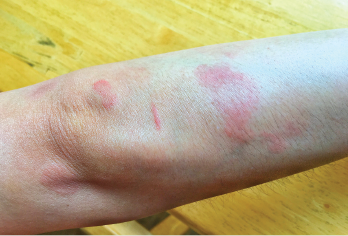
Skin manifestations of SLE.
korn ratchaneekorn / shutterstock.com
CHICAGO—David A. Isenberg, MD, academic director of rheumatology, University College London, presented the ACR Systemic Lupus Erythematosus (SLE) State-of-the-Art Symposium at the 2018 ACR/ARHP Annual Meeting.
Dr. Isenberg began by noting lupus is now widely covered in the news, but singer Selena Gomez has probably done the most to increase awareness of the disease; her 2017 kidney transplant Instagram received more than 10 million likes. He encouraged rheumatologists to match this awareness and “up our game” with clinical assessment and understanding the totality of the effects of lupus on the patient.
Early recognition and treatment of SLE is important, Dr. Isenberg emphasized. Physicians should also be aware that damage from lupus implies permanent change, and lupus presents differently in different age groups. Although blood tests results reveal immunological changes in all patients, younger patients tend to have lower levels of C3. Younger patients are also more likely to have alopecia.
Treatment Strategies
Dr. Isenberg described SLE treatment strategies, explaining patients who have mild disease with fatigue and only malar rash should be treated with a single shot of steroids, with the possible addition of hydroxychloroquine (HCQ) and topical steroids. These patients can continue on a moderate dose of steroids and HCQ. Recent research suggests the use of glucocorticoids is more tightly associated with the treatment center than with patient symptoms or patient outcomes, meaning it may be possible to maintain patients without glucocorticoids.
However, patients with moderate disease will likely require steroids and a maintenance dose of prednisone, Dr. Isenberg noted. These patients tend to present with fever and a larger rash. Although they may have renal involvement, it is not severe. In contrast, patients with severe disease tend to have large rashes, as well as severe pleurisy and/or pericarditis. These patients require more medications and are more likely to require steroids and immunosuppressive drugs for an extended period. Antimalarial agents, such as HCQ, adjunctive therapies and immunomodulation should all be considered as treatment options. Patients with lupus nephritis should be treated with immunosuppression for at least three years.
“Clearly, one has to see lupus patients regularly,” emphasized Dr. Isenberg, because it is vital to monitor drugs used in therapy closely. Regular visits should include serological tests, because an increase in double stranded DNA antibody is associated with an increased risk of renal disease. Regular management should also include awareness of the increased risk for infection, cancer, vascular disease and osteoporosis; previously the major concern for patients with SLE was kidney failure.
Moreover, Dr. Isenberg pointed out the importance for healthcare providers to recognize concomitant damage may not necessarily be the result of disease activity. Shortness of breath, for example, could be due to pleuritis or pulmonary fibrosis. For each symptom, it is critical to question whether the symptom reflects disease activity or damage.
Treat to Target
Dr. Isenberg also discussed treat to target and its meaning for SLE. He emphasized damage in lupus predicts future damage and death, thus one treatment goal is to avoid damage. The target for SLE treatment, he explained, should be remission of systemic symptoms and organ manifestations as indicated by the lowest possible disease activity, but treatment of clinically asymptomatic patients should not be escalated if the patient has stable/persistent serological activity. Instead, healthcare providers should address the factors that negatively influence health-related quality of life, such as fatigue or pain.
Patients in remission should have no clinical features, no abnormal serologies and no requirement for steroids/immunosuppression. Unfortunately, even patients with full remission may flare, and one study suggested at least half of patients will flare over the course of a year.1 Another study of patients in full remission for three years found one in five went on to have a flare.2 Nevertheless, remission is an important treatment goal because patients who spend more than 50% of their observed time in a low disease activity state have significantly reduced organ damage.
For the most part, physicians have chosen the drugs to treat lupus based upon their anti-inflammatory properties. Now, however, lupus is recognized as a disease of waste disposal in which the DNA fragments appear to be picked up by antigen-presenting cells, Dr. Isenberg stated. This understanding should make it possible to develop therapies targeted at SLE-specific pathways.
Patients who spend more than 50% of their observed time in a lupus low disease activity state have significantly reduced organ damage.
Biologic Treatments
Meanwhile, rheumatologists have investigated the uses of many biologic treatments as therapies for lupus. Unfortunately, many of the clinical trials have failed. The exception is belimumab (Benlysta), an antibody against B lymphocyte stimulator, also known as B cell-activating factor, which has been approved by the U.S. Food and Drug Administration and the National Institute for Health and Care Excellence (NICE) for use in patients with SLE who have skin and joint disease. Long-term studies have confirmed belimumab is a safe drug that seems to be beneficial for about two-thirds of patients with lupus.
Dr. Isenberg concluded his presentation by stating the mortality rate for patients with lupus has clearly improved significantly over the past 50 years. Rheumatologists are now moving from an era of treatment serendipity to where it is becoming possible to introduce new therapies on a more rational basis. Unfortunately, thus far, except for belimumab and abatacept (anti-cytotoxic T-lymphocyte-associated antigen 4 [anti-CTLA-4]), biologic drugs have not been very successful in treating lupus, Dr. Isenberg stated.
So as we enter 2019, rheumatologists await the results of more, hopefully more successful, trials in SLE.
Lara C. Pullen, PhD, is a medical writer based in the Chicago area.
References
- Goswami RP, Sit H, Ghosh P, et al. Steroid-free remission in lupus: Myth or reality; an observational study from a tertiary referral centre. Clin Rheumatol. 2018 Dec 6.
- Medina‐Quiñones CV, Ramos‐Merino L, Ruiz‐Sada P, et al. Analysis of complete remission in systemic lupus erythematosus patients over a 32‐year period. Arthritis Care Res. 2016 Jul;68(7):981–987.

